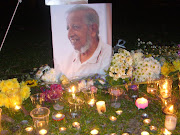A Reuters report from Dec 21, 2007 followed by a Jan 3, 2009 New York Times report.
Rush for land to sweep away last Singapore village
By Melanie Lee
SINGAPORE (Reuters) - Chillis and limes grow in a lush garden between colorful cement houses with leaking metal roofs in Kampong Buangkok, a village with no roads or computers.
The sight would be nothing out of the ordinary in much of southeast Asia. But Singapore's last village, nestled in a forest clearing, is an oddity in the sophisticated city-state where skyscrapers and high-speed Internet are the norm.
Simple kampongs -- the Malay word for village -- were synonymous with disease and poor sanitation when they went out of style as Singapore introduced government housing in the 1960s.
Mass relocations to tower block Housing Development Board (HDB) flats saw the number of kampongs dwindle. Once home to 40 families, sole survivor Kampong Buangkok now houses only 28, who fiercely guard community bonds among arching banana trees.
"I know all my neighbors, we meet every day, doors open. It's not like the HDB flats, where you can live and not know anyone," said Ramlah binte Kamsah, a secretary in her mid-forties who has lived in the kampong for 40 years.
The village in northeast Singapore, the size of three football fields, has few cars.
"They always ask me if I want to build a road here, but I tell them -- no road. Real kampongs don't have roads," said Sng Mui Hong, owner of the land of Kampong Buangkok, gesturing to the dirt path which runs through the village.
Sng, who is single and in her fifties, inherited the piece of land from her father. While the booming economy and an influx of foreigners has led to a red hot property market, her rates are as low as $6.50 ($4.45) a month -- prices maintained for 30 years.
"If you increase the rent and the prices outside go up, how will the people in here cope?" said Sng, who added that most kampong dwellers are poor and shun Singapore's glitzy malls.
HITTING HERITAGE
Built 60 years old ago on low-lying land, the kampong has weathered many floods.
But the biggest danger it faces is not a natural disaster, but Singapore's voracious appetite for land.
In Singapore, history and heritage are often found at the receiving end of a wrecking ball.
The space-starved island, about one third the size of Greater London, has one of the world's highest population densities. For decades it has reclaimed land from the sea and razed landmarks to make space for development.
"Of course we want to preserve the kampong -- sentimental fools like us. These are the last traces of old Singapore, everything old has been torn down," said Victor, 51, a blogger who writes about life in old Singapore.
However, a government plan aims to turn the kampong into schools and housing.
"Given the need to optimize the use of land in land scarce Singapore, it may not be viable to retain the kampong in its current state," said a spokeswoman from the government redevelopment agency.
Sng has made it clear to private developers that she does not intend to sell her land. But the reality is she would have to sell the land to the government if required, based on the state's laws. Some villagers fear they may only have a year left.
Tan Choon Kuan, 75, comes to the kampong every Sunday with his family to paint. His grandson Nicholas Goh, 17, said the kampong is a "refreshing change from urban Singapore," as they sat next to half-painted canvasses and smoking mosquito coils.
"I can't do much about the government plans to redevelop the land. But by painting these scenes, I preserve it for the future generations," Tan said, dabbing brush strokes on a leafy picture.
(Editing by Neil Chatterjee and Gillian Murdoch)
Urban Singapore Prepares to Gobble Up Its Last Village
by Seth Mydans
It is Singapore’s secret Eden, a miniature village called Kampong Buangkok that is hidden in trees among the massed apartment blocks, where a fresh breeze rustles the coconut palms and tropical birds whoop and whistle.
With just 28 houses in an area the size of three football fields, it is Singapore’s last rural hamlet, a forgotten straggler in the rush to modernize this high-rise, high-tech city-state. But apparently not for much longer. Kampong Buangkok is designated by the government for demolition and redevelopment, possibly in the near future. When it is gone, one of the world’s most extreme national makeovers will be complete.
Kampong is a local word for village and also defines a traditional rural way of life that Singapore has left behind.
“The big overhaul began in the early 1960s,” said Rodolph de Koninck, a professor of geography at the University of Montreal and one of the authors of “Singapore: An Atlas of Perpetual Territorial Transformation,” which graphically charts a half-century of change.
As the decades passed, a clamorous tropical settlement reinvented itself as a spic-and-span outpost of the developed world.
Now 90 percent of Singapore’s population has been moved into government housing, and many people have moved at least once again as the city continues to change.
“Everything is up for redevelopment,” Mr. de Koninck said. “Even downtown, things that were developed in the 1960s and 1970s are already being torn down.”
When Sng Mui Hong’s father bought the land in 1956, Kampong Buangkok was a muddy village like hundreds of others around Singapore. No one could have guessed that it would be the last.
Under the city’s master plan, at an unannounced date Kampong Buangkok will be “comprehensively developed to provide future housing, schools and other neighborhood facilities,” said Serene Tng of the Urban Redevelopment Authority in an e-mail message.
Ms. Sng, 55, is now the landowner, wheeling her bicycle among the metal-roofed, one-story homes of her tenants, who are also her friends and pay only nominal rents for their houses.
The government provides electricity, running water and trash collection, and once a day a postman comes by on his motorcycle.
Ms. Sng grew up here, and many of her neighbors were her childhood companions. Few people in Singapore of her generation can say that.
Fruits and flowers cluster in the village like endangered species in a vanishing ecosystem. There are tiny guavas and giant papayas, yams and tapioca plants, dill and edible bamboo shoots, bougainvillea and hibiscus.
Snakes and lizards scurry through the undergrowth, and tiny fish swim in a tiny stream.
Through the trees in all directions, the people of Kampong Buangkok can glimpse the government housing blocks that represent their future.
Under Singapore law, the government can buy the land at any time, at a designated price, and Ms. Sng has already prepared herself.
“If there’s a change, I won’t have my friends any more,” she said, but added: “We must not cling on to things. If the government wants to take the land, they will take it.”
There is no question that Singapore needs the land.
Its population, which was 1.6 million in 1960, has grown to 4.8 million living in an area less than 300 square miles, one of the world’s highest population densities. Planners project a growth of nearly 40 percent by midcentury, to 6.5 million.
“We will need to optimize land use, whether it is though reclamation, building upwards or using subterranean space,” Minister of National Development Mah Bow Tan said recently, in describing the plans for population growth.
To make more space, neighborhoods are razed, landmarks are sacrificed and cemeteries — an inefficient use of land — are cleared away, the buried remains cremated and placed in vaults.
In its most ambitious development project, Singapore has simply made itself bigger. In 1957 its land area was 224 square miles. Since then vast amounts of landfill, dumped into the sea, have expanded it by more than one-third, to 299 square miles.
Few people in Singapore know that one village still survives, hidden in trees 200 yards from a highway.
“Even if I want to show my children how I was brought up I can’t show them,” said Ho Why Hong, 50, a taxi driver, as he searched for Kampong Buangkok. “Everything is torn down.”
“When we were growing up we didn’t lock our doors,” he said. “That kind of trust we had. Everyone knew each other. Any stranger who came into the kampong, we knew.”
In modern Singapore, few neighbors know each other, said Sarimah Cokol, 50, who grew up in Kampong Buangkok and now lives in one of the apartments that people here call pigeonholes.
“Open door, close door,” she said in the terse speech of no-nonsense Singapore. “After work, go in. Close door.”














8 comments:
Dear Jacob,
Thank you for bringing this to my attention. The naive and cocky city-slicker that I am, I was surprised to find out that kampongs existed even up until 2007.
I have been living abroad for some time now, but I plan to visit home soon. Do you know if the featured kampong still exists?
Regards.
Dear Anon,
You're welcome. :-)
If i'm not wrong, its still around but it could go anytime soon.
I've been keeping an eye out for any news. I would appreciate it if somebody could get updated information and post it as comments here.
Dear Jacob,
Thank you for the response.
I have never seen the kampong, and I hope to catch it when I get back. But now that I think about it, I used to play football weekly with my social team at the field(s) near the old Woodbridge Hospital -- this was back in the early to mid-90s. So I am guessing that the kampong must be nearby, given the reference to the hospital in the documentary.
Initially, there was only one field. But the enterprising referee made space enough for two over time, thus doubling his income. The locale was a hotbed for social soccer teams. Fond memories.
Again, thank you for advertising a slice of Singapore history in the public domain.
Regards.
Dear Anon,
I hope these will help:
http://tinyurl.com/9o8sml AND http://tinyurl.com/8md53t
Btw Anon, thanks for sharing your memories. :-)
There are some directions HERE via bus/mrt/lrt.
Dear Jacob,
Great to see such a nice video about this Kampong. i used to stay inside this Kampong 20+ ago.
fond memories of taking bus beside the Shell petrol station, eating roti prata along the "Eight Mile Stone" shophouses, buying "titam" at the provision shop, to many to list man....
Regards
DL
Dear DL,
I'm glad it brought back fond memories for you. Thanks for sharing. :-)
Post a Comment